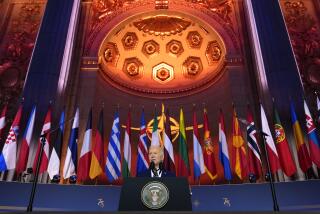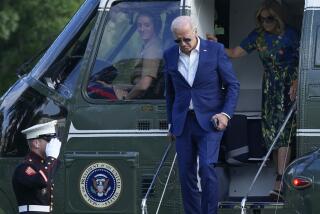A Small World of Obsolete U.S. Alliances
New Zealand is not the typical renegade state. Sheep outnumber people 23-1; violence is confined to rugby fields; the national symbol is the diminutive kiwi. Yet five weeks ago, the island nation became the first Western democracy ever expelled from an anti-communist military alliance.
Representatives from the United States and Australia will gather in San Francisco next weekend for the annual meeting of ANZUS, the South Pacific mutual-defense pact once linking Australia, New Zealand and the United States. The agenda should be brief, since neither insurgency nor subversion currently threatens Oceaniaâs scattered atolls. Yet there is that one embarrassing problem the alliance must confront: the absence of its third ally.
Conflict between Washington and Wellington began two years ago when Prime Minister David Lange banned nuclear warships from New Zealandâs ports. His goal was to transform the South Pacific into a nuclear-free zone. But the effect of the policy was to make military coordination among ANZUS partners impossible since Washington refuses, for security reasons, to disclose which of its Pacific Fleet ships carry nuclear weapons.
ANZUS devolution from multilateral treaty to bilateral agreement is unlikely to affect the balance of power in the Pacific. It does raise doubts about the future value of strategic military alliances that have been the bulwark of Washingtonâs policy of Soviet containment for the better part of four decades.
Multilateral defense pacts were the result of Soviet expansionism and the fear that postwar America might return to the isolationism of the 1930s. Though eight European countries became Soviet satellites within 11 months of Germanyâs defeat, the late W. Averell Harriman fumed at the time that Americans only wanted âto go to a movie and drink Coke.â The Marshall Plan could never succeed without the stability provided by a North Atlantic Treaty Organization. If exaggerating the Soviet threat would hasten the creation of NATO, reasoned Secretary of State Dean Acheson, then perhaps it was necessary âto make things clearer than the truth.â
In 1947, Washington buttressed the Monroe Doctrine with the Rio Treaty, making all but three of the Western Hemisphereâs nations responsible for their collective defense. With its southern flank secure, America turned its attention to Europe, where 10 countries in 1949 joined Canada and the United States to form NATO. (By 1954 the alliance totaled 15 countries with the addition of Greece, Turkey and West Germany).
NATO was followed two years later by ANZUS, which became the foundation for the 1954 creation of the Southeast Asia Treaty Organization (SEATO), a jumble of eight countries loosely pledged to the protection of non-communist Indochina. The following year, the Central Treaty Organization (CENTO), formed by Iraq, Turkey, Iran, Pakistan, Britain and the United States, extended NATOâs defense line from Turkey to India.
CENTO completed the theoretical encirclement of Moscow. An anti-communist frontier ran down the Elbe River and through the middle of Berlin, along the 38th parallel in Korea and the 17th parallel in Vietnam. The islands of Quemoy and Matsu separated Maoâs China from Nationalist Taiwan. There was even a 3,000-mile stretch where the northern frontiers of Turkey and Iran overlapped the Soviet Unionâs southern border.
Strategic alliances halted Moscowâs blitzkrieg expansionism. But they never became the impermeable barrier conceived by Acheson and Sovietologist George F. Kennan. In 1956, Moscow leapfrogged CENTO to establish a beachhead in Gamal Abdel Nasserâs Egypt. The overthrow of Iraqâs pro-Western monarchy in 1958 left a gap in CENTO. When Soviet troops later rolled through Hungary and Czechoslovakia, NATO dithered. Spurned by Indonesia, Burma, Malaysia and Singapore as a tool of the West, SEATO consisted of nothing more than its charter. Four of its eight signatories eventually sent token detachments to Vietnam, but the armed raids they mounted usually targeted the nearest PX.
In retrospect, the greatest flaw of the multilateral alliances was an inability among many allies to distinguish between containment and deterrence. The status-quo posture on which containment was based held little appeal for emerging African nations already embittered by the colonial experience. This rigidity proved fatal when Moscow, under the leadership of Nikita S. Khrushchev, began to champion wars of national liberation.
Of the four multilateral alliances, only NATO was structured for mutual defense. Were it not for the threat posed by the Warsaw Pact, it is doubtful that NATO could have survived the withdrawal of France, the rise of Euro-communism and the controversial deployment of Pershing missiles. SEATO and CENTO were little more than ideological statements. Weakened by the defection of Iraq, CENTO became a dead letter in 1972 when, after the secession of East Pakistan, not one ally responded to Pakistanâs call for help in the resulting war with India. In its final years, CENTO consisted of the Shah of Iran; with his overthrow the organization died.
New Zealandâs departure from ANZUS underscores the fact that an alliance with a superpower can offer more liabilities than benefits. Trade preferences and reduced defense costs provided by a superpower must be weighed against the dependent allyâs isolation and loss of control.
Can an alliance once designed to repel tanks survive in a world now plagued by guerrilla insurgency and terrorism? For the moment, NATO remains the cornerstone of U.S. strategic defense, but its value is no longer beyond question. Many analysts speculate that if confronted with a Soviet advance into Europe, Washington would be unable logistically to support its European ground forces and unwilling to trigger a nuclear war.
âThirty-six years after the founding of NATO, the defense of Western Europe still rests on the proposition that an American President will invite the destruction of our cities and the incineration of 100 million of our citizens to repel a Soviet incursion or resist a Soviet ultimatum to Western Europe,â Earl Ravenal, Georgetown professor of international relations, argued in a 1985 Foreign Policy article.
âOn its face, Americaâs war plan . . . is the first use of nuclear weapons, if necessary, to defend Europe. But, under the surface, Americaâs nuclear commitment to Europe is not so sure,â Ravenal stated.
The most critical variable in any strategic equation is the defense budget. Some economists believe Washington will run out of money long before it exhausts its will to resist. The United States this year will spend $241 billion on defense of Western Europe, while its 12 NATO allies, with a combined GNP of $2.6 trillion, contribute only $83 billion. This disparity does not bother Defense Secretary Caspar W. Weinberger, who concluded in a recent summary of U.S. defense strategy that âour forces must be adequate not only to deter Soviet aggression, but also to be seen by our allies as sufficient.â
Taxpayers, already confronted by a $155-billion deficit, however, may eventually conclude that itâs cheaper to coexist with a potential enemy than support a proved ally.
More to Read
Sign up for Essential California
The most important California stories and recommendations in your inbox every morning.
You may occasionally receive promotional content from the Los Angeles Times.










